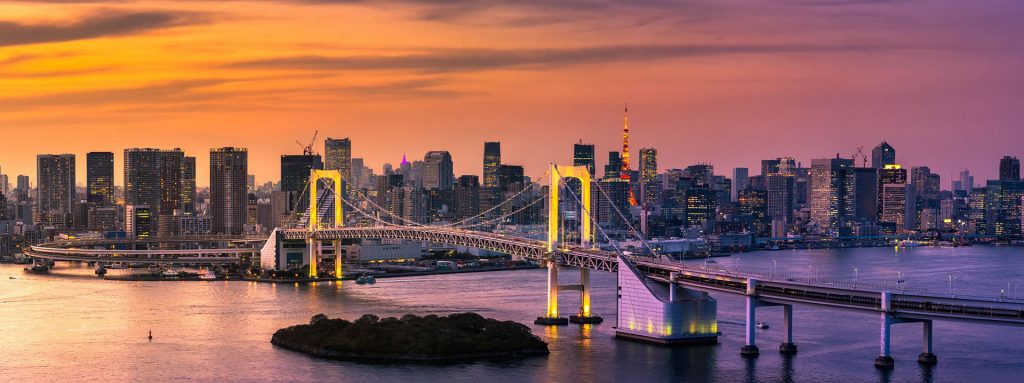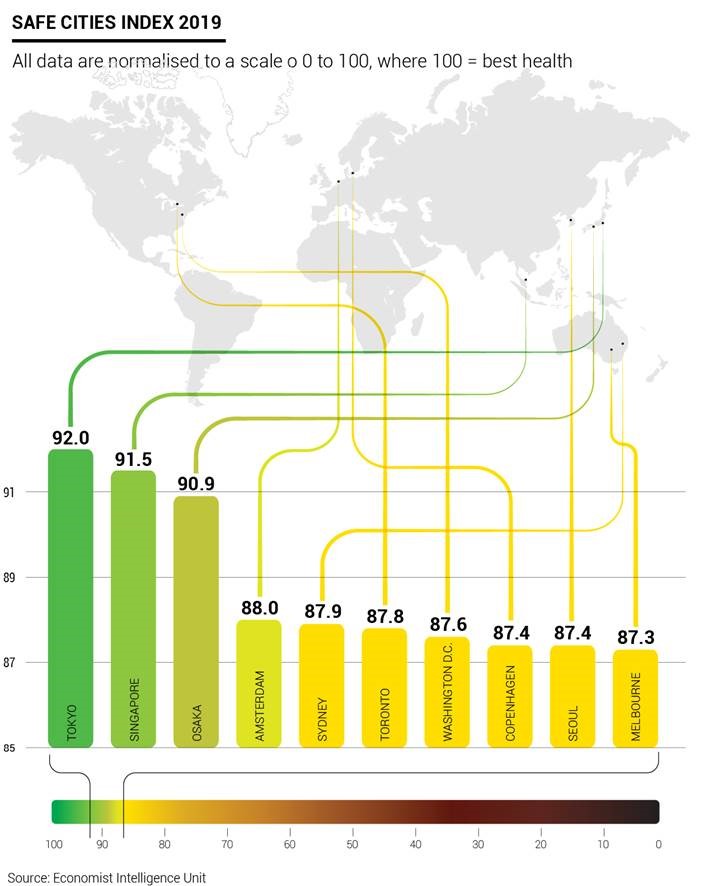
Despite the earthquakes that periodically rock its buildings, Tokyo is the safest city in the world, according to the Safe Cities Index 2019, the study carried out by the Economist Intelligence Unit and financed by the telecommunications giant Nec.
Personal safety, a good health care system, and infrastructure quality contributes to Tokyo’s lead, with two other Asian cities nipping at its heels: Singapore and Osaka. Asia dominates the top ten with four of the safest metropolises in the world (with Seoul tying for eighth place with Copenhagen), followed by Europe with Amsterdam and Copenhagen, by North America with Toronto and Washington D.C. and Australia with Sydney and Melbourne.
The study looks at digital security, violent crime and infrastructure security in 60 cities around the world, in a valuable guide that helps understand how cities will cope with the looming demographic boom that will impact the lifestyles of their inhabitants.
Big cities face a demographic boom
Currently 56% of the world population lives in urban centers, a percentage that is destined to grow up to 68% by 2050, said the study.
According to the think-tank New Climate Initiative, urban areas are responsible for 85% of global GDP and 76% of gas emissions in the atmosphere. That’s why urbanization must be accompanied by modern infrastructure projects, which reduce congestion and encourage a sustainable model of lifestyle and transport. An increasing number of cities risk “outgrowing” their infrastructure. According to the United Nations, nine cities now have more than 20 million inhabitants, and the number will rise to 14 by 2020. Not only that, between 2020 and 2025, the 30 largest metropolises in the world will see their population increase by 45 million residents. Already today 80% of the population living in the countries of Western Europe, the United States, Canada and some regions of Asia is concentrated in urban centers.
Safe infrastructures for the megalopolises of the future
Infrastructure security is one of the key factors contributing to a city’s safety, the EIU study found. It looked at numerous aspects: the number of deaths and accidents on the roads; the size of underground subway networks; urban transport railways; and resistance to dramatic weather events.
In terms of infrastructure safety, Singapore has overtaken Tokyo. According to the Global Infrastructure Outlook published by the G20, Singapore will invest $94 billion for infrastructure to 2040, a sizeable figure for a single city. In fact, Singapore sees infrastructure as a driving force for growth and has launched a series of projects supported by the World Bank and the Asian Development Bank.
As a result, its infrastructure quality is above the world average in all sectors, from roads to underground lines, from ports to air transport, from energy supply to railways.
Ranking behind Singapore in terms of infrastructure security are Osaka, Barcelona, Tokyo and Madrid. These two Spanish cities have invested a great deal in sustainable mobility in recent years.

Tokyo’s leadership
Tokyo has ranked at the top of the EIU’s Safe Cities index for the last three consecutive editions of the survey, in 2019, 2017 and 2015, because of the city’s long-term vision about the importance of safety.
«Given that earthquakes are endemic to Japan and we are also witnessing major climate change around the world, it is utterly critical that Tokyo protects residents and the city from natural disasters», said governor of the city, Yuriko Koike. «To do so, we have pursued a range of reforms, both on the infrastructure and the intangible side, expending a large budget. Tokyo’s having received high acclaim as a safe city results in part from the steady and consistent way we have pushed forward these initiatives over the years».
In terms of protection from earthquakes, 87% of the buildings were built according to the most modern anti-seismic criteria. Many other investments have been made to protect the city from weather-related catastrophes. Thirteen years of work and an investment of $3 billion dollars was made to build the biggest storm drain in the world. The Metropolitan Area Outer Underground Discharge Channel is a 6-kilometre (3.7 mile) long tunnel designed to collect the enormous flow of water in the wake of a tsunami or a hurricane.
The city has also invested heavily in the development of its infrastructure network. Today its 2,000 square metre (772 square mile) surface area is served by 13 underground lines and 100 surface lines. Transportation is efficient and punctual, and the subway serves a total of 8 million people each day. When it hosts the Olympics in 2020, Tokyo has another chance to show once again it is the safest city in the world.

